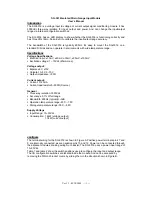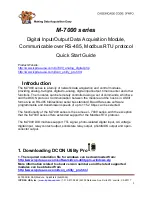
L292.03
23-04-2002
ZVL292.03 / Mod. 23-04-2002
AM
433RC
via Padre Elzi, 32, 24050 - Grassobbio (BG)
Tel.
+39 035 42 42 511 -
Fax.
+39 035 42 42 600
info
@geniusg.com -
www
.geniusg.com
Description
The
433RC
radio control system in "
AM
" consists of one or more transmitters and one or more
receivers which can be combined to meet the specific needs of the system. The
433RC
system uses
a highly reliable encoding system guaranteed by the use of dynamic codes. The code is changed for
each encoding transmission through the use of an encoding algorithm which only the receiver is able
to recognise and therefore decide whether or not the code transmitted corresponds to the original
code. The generated code is memorised in the receiver via radio.
The receiver is able to memorise up to 300 different codes. During the transfer stage the codes are
memorised in a non volatile memory module. As this is a system based on dynamic codes each
code is processed individually by the receiver.
Important
The transmitted code changes for each command (rolling code). If disturbance interrupts the
transmission, the receiver will wait for a different code, the relay can then only be activated by first
releasing and then pressing the transmitter channel button again.
Use
The
433RC
radio control allows the remote activation of electrical and electronic appliances with its
best use in the following areas: automatic opening systems, alarm systems, and in all systems which
require remote control activation (without wires) using secret codes.
Transmitter versions
A252
Pocket transmitters
2 channels
A254
Pocket transmitters
4 channels
Receiver versions
A245
10-pin receiver card (2 outputs: "open collector" + relay)
2 channels
JA228
5-pin receiver card (1 output: "open collector")
1 channel
Memory module
This is extractable, furnished with a non volatile EEPROM type memory and contains the transmitter
codes and allows you to memorise up to 300 codes (300 channel buttons). The programmed codes
are maintained in this module even in the absence of power.
Receiver antenna installation
Minimum and maximum range of the radio controls. "Range" is intended to mean the working distance,
measured in free space, between the receiver and the transmitter with the antenna installed. The range
is therefore closely linked to the technical characteristics of the system (power and sensibility) and
varies according to the characteristics of the site in which the system is located.
It therefore follows that to obtain the best results from the radio control the receiver and antenna
installation sites should be carefully chosen.It is not possible to install 2 receivers at a distance of
less than 1.5 m. from each other. It is good practise to position the receiver away from computer
systems, alarm systems and other possible sources of disturbance.
Antenna
The installation of the antenna is fundamental, connected to the receiver it represents the
reception point for the radio control.
When installing the antenna the following points should be observed:
- The slot-in receiver card is supplied with its own antenna which consists of a piece of
rigid wire
170 mm
in length.
- As an alternative it is possible to connect a tuned antenna using a coaxial cable
RG58
(impedance
50
Ω
) with a maximum length of
15m
. The antenna should be positioned out of doors in the
highest possible point, visible and away from metal structures.
Transmitters
The transmitter is pre-coded
and is fitted with an integrated circuit which is programmed in
the factory with a unique identification number. All the code parameters are contained in this
integrated circuit (external memory modules are not required) thus making code management
more reliable and the system more secure.
The transmitter has an automatic shut down mechanism which cuts in after at least 25 seconds of
continuous use (this limits battery consumption).
Receivers
Warning!
The receivers must only be powered by a safety power pack. The use of non safety
power packs could provoke damage to the system.
The receiver cards must be sufficiently insulated from the parts of the host device which
are powered by the mains.
The receivers is are slot-in cards with molex connectors inserted directly into appliances which
are designed to receive them.
On the
A245
version channel 1 of the slot-in receiver card is an "open collector" while channel 2 is a
NO-C contact (binding posts 1-2 fig.5 det. "
C1
"; contacts 7-8 on the Molex connector)
The two channels can be selected using the jumper "
S1
" fig.5a and it is possible to associate the two
functions CH1 and CH2 with one of the four (max) buttons on the transmitter (see fig. 3). The receiver
has an incorporated 433 MHz RF module "
R1
" which is soldered to the card.
The
JA228
version has a single open collector output (contact 3 on the molex connector
fig.5b). This output can be managed by any transmittor channel as long as it has been
memorised in the receiver.
Status led "L1"
Flashing rapidly:
cancelling a single user
Flashing slowly:
memorising a single user
Continuously lit:
memory full
Functions
A. Memorising a channel
B. Cancelling a channel (via an associated radiocontrol)
C. Cancelling the entire user memory
D. Memorising ulterior channels via radio (without having to open the box in which the
receiver is housed)
Attention!
Before memorising the transmitters for the
first time
remember to cancel the
entire memory content.
DIGITAL RADIO CONTROLS WITH DYNAMIC CODES 433RC
A- Memorising a channel
(fig. 4a)
1) Keep button "
P2
" MEMO pressed down and the led "
L1
" will start to flash slowly
2) Press the channel on the transmitter which is to be memorised
3) Keep button "
P2
" MEMO pressed down until led "
L1
" starts to flash again
4) Release the button and the led continue to flash
5) Press the channel on the transmitter which is to be memorised again (same transmitter,
same channel. If the channel or the transmitter is different you will not be able to memorise
the channel.
6) End of the memory procedure. Led "
L1
" will remain lit for 2 seconds meaning that the channel
has been correctly memorised.
• It is not possible to memorise a user code that is already in memory: In this case when the
radiocontrol is activated (point 2) the led will stop flashing. The program will only work again when
button "
P2
" MEMO has been released.
• If the radiocontrol is not activated a second time within fifteen seconds the program will
automatically leave the memory mode without memorising a new user code.
• If a new user code is activated the first time and a different channel (with an already memorised
user code) is actived the second time, the program will automatically leave the memory
mode (because the two codes do not correspond) and the channel present in the second
transmission will be activated.
Note
:Once you have entered the second part of the memorising procedure (point 4 onwards) you
will have to complete the entire procedure. If you do not wish to memorise a code which you have
already transmitted wait for fifteen seconds without doing anything, the led will switch off and the
code will not be memorised. When the receiver's memory is almost full the user search function
can take upto one second to complete.
B- Cancelling a channel
(fig. 4a)
1) Keep button "
P1
" DELETE pressed down and the led "
L1
" will start to flash rapidly
2) Press the channel on the transmitter which is to be cancelled
3) Led "
L1
" will remain lit for 2 seconds meaning that the channel has been cancelled.
Note:
If the user which is to be cancelled is not found in the memory, the led will stop flashing and
will work again when button "
P1
" has been released.
If the button is released before a channel is activated the program will automatically leave the
memorising or cancelling mode.
C- Cancelling the entire user memory
(fig. 4a)
1) Keep buttons (P1+P2) pressed down simultaneously for more than 4 seconds
2) Led "
L1
" will remain lit for the period of time required for the program to cancel all the
codes (about 8 seconds)
3) Led "
L1
" will then turn off meaning that the cancellation procedure has been carried out.
D- Memorising ulterior channels via radio
(fig. 4b)
• Memorisation can be activated by radio (without opening the receiver container) if jumper
"
J2
" has been inserted (fig. 5).
1) Make sure that the jumper "
J2
" has been inserted in receiver.
2) Using a transmitter, in which at least one channel button "A,B,C or D" has already been memorised
in the receiver, press the button "
MR
" as shown in figure "
4b
".
Note: all the receivers within range when the channel button is pressed (and which have
at least one of the transmitter channel buttons memorised) will activate their signal buzzer
"
B1
" (fig. 5).
3) Press one of the channel buttons on the transmitter. The receivers which do not contain
that channel code will sound a five-second long "beep" and will then disactivate. The
receivers which contain the channel code will sound a one-second long "beep" and will
enter the programming mode.
4) Press one of the channel buttons on the transmitter which you wish to memorise; the
receiver will sound 2 "beeps" of half a second each after which the receiver will be ready
to receive another code.
5) To leave the programming mode wait for 3 seconds without pressing any buttons. The receiver will
sound a 5 sec. long "beep" and will then exit the programming mode.
• When the memory is entirely occupied the buzzer will sound 10 rapid "beeps" and will
automatically leave the "
programming via radio
" mode. Led "
L1
" will remain lit on the
receiver. The same signal is given each time you try to enter "
programming via radio
"
when the memory is full.
TECHNICAL SPECIFICATIONS
Receiver
- reception frequency ........................................................................................................ 433,92 Mhz
- local oscillation frequency ............................................................................................. 433,42 Mhz
- local oscillation emission .........................................................................................<57dBm (<2nW)
- antenna impedance in input .......................................................................................................50
Ω
- sensitivity (finely tuned signal) .................................................................................................... 1 µV
- power supply
A245
(via jumper J1) .............................................................................12-24 Vac/dc
- power supply
JA228
............................................................................................................... 24 Vdc
- maximum power consumption relay at rest/activated ........................................................20/45mA
- maximum commutable power at the relay with resistive load:
load ac/dc ......................................................................................................................... 60VA/24W
- maximum voltage .............................................................................................................. 30Vac/dc
- dropout delay ..........................................................................................................................250 ms
- operating temperature range .........................................................................................-20°…+60°C
- maximum command response time ....................................................................................1 second
- minimum command response time ...............................................................................30 ms (circa)
Transmitters
- carrier frequency ............................................................................................................. 433.92 Mhz
- carrier frequency tolerance ................................................................................................... ±75 Khz
- apparent radiated power ......................................................................... -10…-7dBm (100-200µW)
- apparent power harmonic products ......................................................................<-54 dBm (<4nW)
- modulation ............................................................................................................................AM/ASK
- signal modulation .................................................................................................... PCM, 1.2 ms/bit
- power supply (Alkaline battery GP23A) ........................................................................... 12V ± 10%
- maximum power consumption ................................................................................................ 30 mA
- operating temperature range .......................................................................................... -10…+55°C
- number of possible code combinations (28 bit fixed part) .............................more than 268 million
- total number of possible code combinations (66 bit) .................................................................. 2
66
- maximum number of channels .........................................................................................................4
- automatic shut down ..................................................................................after at least 25 seconds
MODEL
DATE
CODE Nr.
SERIES
This product has been tried and tested in the manufacturer's laboratory,
during the installation of the product follow the supplied indications
carefully.























